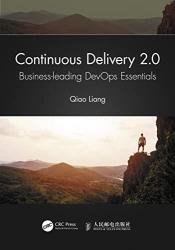Continuous Delivery 2.0: Business-leading DevOps Essentials
- Добавил: literator
- Дата: 12-11-2021, 13:51
- Комментариев: 0
 Название: Continuous Delivery 2.0: Business-leading DevOps Essentials
Название: Continuous Delivery 2.0: Business-leading DevOps EssentialsАвтор: Qiao Liang
Издательство: CRC Press
Год: 2022
Страниц: 362
Язык: английский
Формат: pdf (true)
Размер: 24.8 MB
Since the term “software engineering” was coined, “quality” and “efficiency” have been its goals. Most information technology (IT) institutions have been making explorations along this path, they first came up with the waterfall model and then Capability Maturity Model Integration (CMMI) which has been worshiped as the “Bible” by many IT groups. When the “agile movement” arose, they decided to “do” Agile; when they heard about “Continuous Delivery”, they changed their mind to “do” Continuous Delivery. Now DevOps has come out and swept around the IT industry, becoming topic of salons and conferences and even hit the headline of various media. Not surprisingly, many companies cast their eyes at DevOps…
The goal of this book is to help all roles in a company change their way of value thinking, improve the end-to-end business value delivery in software services, raise the teamwork efficiency, so as to achieve fast verification in a safe and reliable way, and shorten the time to realize genuine business value. In other words, the book not only elaborates on the process “from product backlog to workable software”, but also proposes a double closed loop as “value discovery-fast verification”, which implies the origin of “Continuous Delivery 2.0” – title of this book.
The agile transformation is an act of transforming an organization’s form or nature gradually to one that can embrace and thrive in a flexible, collaborative, self-organizing, and fast-changing environment. It seems like most of the companies starting an agile transformation never reach the goal of agility, but there are those few that truly become agile and reap incredible benefits by utilizing DevOps as well.
This book introduces the theory and practice of the "double-flywheels model" of Continuous Delivery 2.0: Discovery Loop, which allows information technology (IT) organizations to help businesses figure out the most efficacious ways to develop. Additionally, it explores applications of the Verification Loop that allows IT organizations to deliver value quickly and safely with high quality. Along the way, the book provides an array of insights and case studies that dive into all the aspects of software delivery, and how to implement Continuous Delivery in the most economical way for long-run business development.
Features:
· Organization Culture and Software architecture
· Business requirement management
· Pipeline and tooling
· Branching and releasing strategy
· Automation Strategy
· Configuration and artefacts management
· Deployment and Production healthy
The case studies at the end of the book—scenarios in which the author was personally involved—are explored in depth and meticulously detailed in order to represent typical agile transition scenarios that will benefit all readers.
Скачать Continuous Delivery 2.0: Business-leading DevOps Essentials
Внимание
Уважаемый посетитель, Вы зашли на сайт как незарегистрированный пользователь.
Мы рекомендуем Вам зарегистрироваться либо войти на сайт под своим именем.
Уважаемый посетитель, Вы зашли на сайт как незарегистрированный пользователь.
Мы рекомендуем Вам зарегистрироваться либо войти на сайт под своим именем.
Информация
Посетители, находящиеся в группе Гости, не могут оставлять комментарии к данной публикации.
Посетители, находящиеся в группе Гости, не могут оставлять комментарии к данной публикации.
